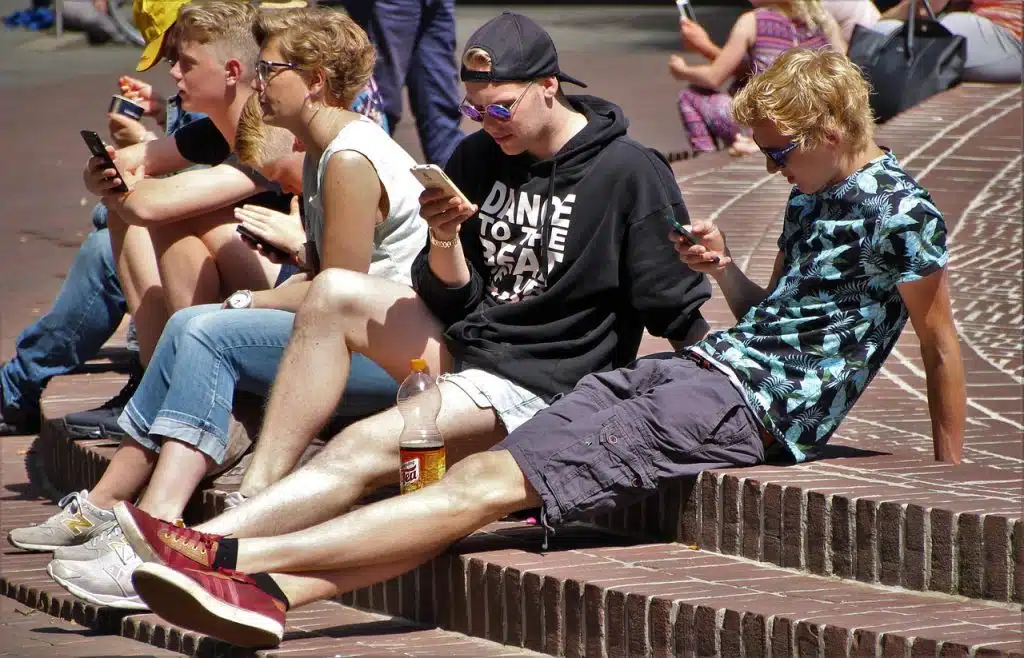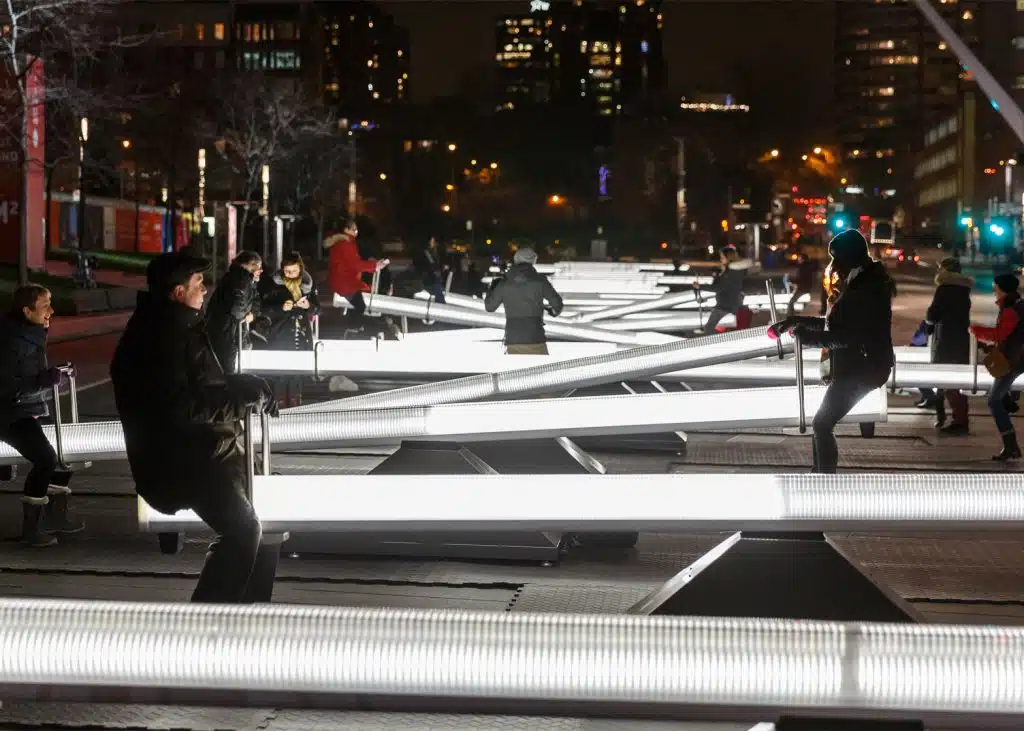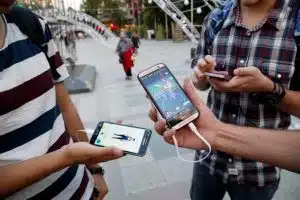“What gunpowder did for war the printing press has done for the mind.”
—Wendell Phillips
No matter the era, technology has both a positive and negative impact on our lives. It all depends, of course, on how it’s used.
Most of America, apparently, would agree with that statement. When asked what the Digital Revolution’s impact has been on the overall quality of life in a 2015 Heartland Monitor poll, 62% of our participating neighbours believed that it has a mixed positive and negative impact. Less than half felt it was socially isolating and detrimental to forming communities.
It’s hard to measure the true impacts of technology, particularly social platforms, but there is undoubtedly huge potential for technology to benefit our connectivity as social creatures. What types of technology enrich our social connections? Over the next few weeks, Limbic Media will discuss how technology influences us socially.

Heads-Up vs. Heads-Down Technology
Opinions in that Heartland poll were, unsurprisingly, more divided when parsed by demographics such as age, education, employment status and whether or not the participant had children. Even with a subjective question like “does technology help or hinder us,” people still have very straightforward opinions about how tech negatively affects relationships, whether app addiction affects our social life or the danger of distraction has an impending threat to our survival.
Heads-up tech focuses our attention on our surroundings and encourages shared experiences
Most conversations about human connection and technology, however, seem to lump “technology” into a single category. Evidently, not all technology affects how we interact with each other in the same way. It really comes down to the specific product, and again, how we decide to use it.
Since we don’t have time to discuss the effect of individual products on human connection, we can simplify things by describing most social technology as “heads-up” or “heads-down” (or a combination of both). Heads-up tech focuses our attention on our surroundings and encourages shared experiences, while heads-down tech tunes out our surroundings. Both types are beneficial in the right doses and settings, but for the purpose of expanding real-life human connection, heads-up is the better approach.
Shared Experience Models Are Gaining Traction
More companies are engaging with heads-up technology and shared experience models to satisfy customers’ needs for genuine connections. Thinkers like Brian Solis, author of What’s the Future of Business? are emphasizing the presence of shared experiences in company products, services, and internal relations:
“No matter how much or fast technology (social, mobile, real-time) is thrust upon your markets, the one thing that remains constant is that people will use it to connect with one another, learn, and discover, create and curate, and most importantly, share and feel experiences.”

Photo: Leading Authorities
Technologies that serve our need for connection in positive and real ways not only benefit the public, then, but also the longevity of companies that understand the importance of social connections in their business models. We can all benefit from products that force heads-up connections by virtue of their design—what are some tangible examples of companies and products that embody this approach to social technology?
Aurora and Social Wearables
Limbic Media’s very own Aurora (released last fall) and Social Wearables (yet to be officially released), are both designed as heads-up social platforms. Aurora, the world’s most advanced sound-to-light mapping platform, uses interactive sound, light, and technology in public spaces to encourage social engagement through art. Anyone with the free Aurora app can connect with the product’s lighting design AI and control how light shows interact with its audience in real-time. In future releases, Aurora will be able to respond to motion and social media hashtags to influence lighting effects (#blue to change light colour, for example). Aurora is a heads-up social technology that can apply to a variety of social settings.

Photo: CrackerJackFlash
Currently in development, Social Wearables acts as a digital icebreaker. It’s designed to enhance networking opportunities and encourage face-to-face connections in social gatherings like conferences. Social Wearables is a light pendant coloured with RGB LED Lights; when wearers touch their pendant with ones of different colours, it vibrates and collects new shades until they Capture the Rainbow, the first in an upcoming catalog of games. The Social Wearables technology gets people’s attention up, brings people to you and provides a social context for approaching someone you’ve never talked to before.
Interactive Seesaws
Cities like Montreal and Chicago have seen the appearance of interactive seesaws in their city centres. Impulse acts like an urban instrument; the weight and motion of see-sawers create a totally unique composition of sound and light for each duo. The multisensory creation is emitted from each seesaw with speakers and LEDs, and projected in real-time onto surrounding buildings. The heads-up installation is a collaboration between Toronto-based Lateral Office, Montreal’s CS Design and engineering EGB Group. The seesaws are a good example of taking an age-old social platform—playgrounds—and using technology to reinvent it into a public social experience for all ages.

Impulse — Photo courtesy of dezeen.com
Heads-up Apps
Aurora and Impulse are good examples of how heads-up social technology is changing our approach to public space, but what about heads-up technology you can fit in your pocket? People’s desire for more genuine connections is making an impact on app design. Apps that encourage social interaction, physical activity and just plain old getting off your phone are becoming more popular.
The rise in anti-app apps reveals people’s awareness of their overuse of heads-down technology. Apps like Offtime, Moment and Flipd provide users with analytics on their technology consumption, especially with social platforms like Facebook, and encourage you to focus on other social activities and tasks.

Photo: Healthy Families BC
There’s also a vast selection of heads-up apps that act as fitness trackers, designed to encourage social connections through physical activity. Hotseat is a good example of a physical activity app that recognizes the importance of short, frequent breaks at the workplace. Its goal is to to get employees away from their screens for short bursts throughout the day and enhance colleague relationships through exercise and competition. Similarly, Carrot connects friends to create collaborative fitness goals. Successful challenges are met with rewards points for experiential programs like SCENE and Aeroplan Miles.
Augmented Reality Apps
Pokémon Go’s popularity spurred conversations on how augmented reality games and apps reflect our social tendencies. Even though Pokémon Go encourages players to get outside and interact face-to-face with players, a UBC study found that the least successful players tend to self-identify as introverted and socially awkward. The research points to a niche in gaming or other apps—adapting augmented reality to maximize social opportunities, especially for those that struggle to make genuine connections. The most widely used AR apps certainly help people interact with their environment, but there is huge potential for augmented reality to target users that are seeking social interaction specifically.
Technology has made our world more connected than ever before. Ironically, the ease of that connection has left many feeling no more genuinely connected to others. Perhaps the most satisfying aspect of life is obtaining meaningful human connections. Engaging more with heads-up technology over tech that socially isolates us helps bridge the gap between the quantity and quality of our interactions.

Photo: The Arabian Marketer
People resonate with technology that fills the need for real, tangible connections rather than shallow ones. There seems to be an overarching theme with products and businesses that emphasize these shared experience models. From Seesaws to Pokémon Go, we are attracted to heads-up technology that mimics childlike ways of interacting with the world. Children aren’t as capable of tuning out their surroundings; they are field experts at creating connections with the world with zero barriers. Companies that are looking to incorporate more shared experiences into their products and services might need to consider social technologies that can be appreciated by kids and adults alike.
